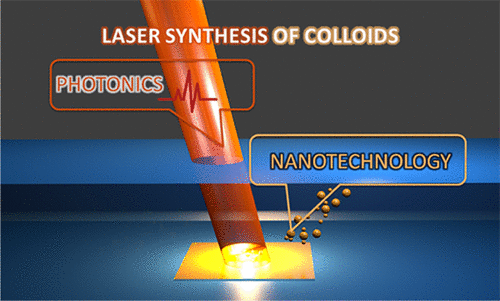当前位置:
X-MOL 学术
›
Chem. Rev.
›
论文详情
Our official English website, www.x-mol.net, welcomes your feedback! (Note: you will need to create a separate account there.)
Laser Synthesis and Processing of Colloids: Fundamentals and Applications
Chemical Reviews ( IF 62.1 ) Pub Date : 2017-02-13 00:00:00 , DOI: 10.1021/acs.chemrev.6b00468 Dongshi Zhang 1 , Bilal Gökce 1 , Stephan Barcikowski 1
Chemical Reviews ( IF 62.1 ) Pub Date : 2017-02-13 00:00:00 , DOI: 10.1021/acs.chemrev.6b00468 Dongshi Zhang 1 , Bilal Gökce 1 , Stephan Barcikowski 1
Affiliation

|
Driven by functionality and purity demand for applications of inorganic nanoparticle colloids in optics, biology, and energy, their surface chemistry has become a topic of intensive research interest. Consequently, ligand-free colloids are ideal reference materials for evaluating the effects of surface adsorbates from the initial state for application-oriented nanointegration purposes. After two decades of development, laser synthesis and processing of colloids (LSPC) has emerged as a convenient and scalable technique for the synthesis of ligand-free nanomaterials in sealed environments. In addition to the high-purity surface of LSPC-generated nanoparticles, other strengths of LSPC include its high throughput, convenience for preparing alloys or series of doped nanomaterials, and its continuous operation mode, suitable for downstream processing. Unscreened surface charge of LSPC-synthesized colloids is the key to achieving colloidal stability and high affinity to biomolecules as well as support materials, thereby enabling the fabrication of bioconjugates and heterogeneous catalysts. Accurate size control of LSPC-synthesized materials ranging from quantum dots to submicrometer spheres and recent upscaling advancement toward the multiple-gram scale are helpful for extending the applicability of LSPC-synthesized nanomaterials to various fields. By discussing key reports on both the fundamentals and the applications related to laser ablation, fragmentation, and melting in liquids, this Article presents a timely and critical review of this emerging topic.
中文翻译:

激光合成和胶体加工:基本原理和应用
在无机纳米胶体在光学,生物学和能源领域应用的功能性和纯度要求的驱使下,其表面化学已成为人们广泛研究的主题。因此,不含配体的胶体是理想的参考材料,可从初始状态评估表面吸附物的作用,以实现面向应用的纳米整合。经过二十多年的发展,激光合成和胶体加工(LSPC)已成为一种方便且可扩展的技术,用于在密封环境中合成不含配体的纳米材料。除了LSPC生成的纳米粒子的高纯度表面外,LSPC的其他优势还包括其高通量,制备合金或一系列掺杂纳米材料的便利性以及适用于下游加工的连续操作模式。LSPC合成胶体的未经筛选的表面电荷是实现胶体稳定性和对生物分子以及载体材料的高亲和力的关键,从而能够制造生物结合物和非均相催化剂。LSPC合成材料的精确尺寸控制(从量子点到亚微米球)以及最近的向克级尺度的升级,有助于将LSPC合成纳米材料的适用性扩展到各个领域。通过讨论有关激光烧蚀,碎裂和液体熔化的基本原理和应用的关键报告,本文对这一新兴主题进行了及时而严格的综述。
更新日期:2017-02-13
中文翻译:

激光合成和胶体加工:基本原理和应用
在无机纳米胶体在光学,生物学和能源领域应用的功能性和纯度要求的驱使下,其表面化学已成为人们广泛研究的主题。因此,不含配体的胶体是理想的参考材料,可从初始状态评估表面吸附物的作用,以实现面向应用的纳米整合。经过二十多年的发展,激光合成和胶体加工(LSPC)已成为一种方便且可扩展的技术,用于在密封环境中合成不含配体的纳米材料。除了LSPC生成的纳米粒子的高纯度表面外,LSPC的其他优势还包括其高通量,制备合金或一系列掺杂纳米材料的便利性以及适用于下游加工的连续操作模式。LSPC合成胶体的未经筛选的表面电荷是实现胶体稳定性和对生物分子以及载体材料的高亲和力的关键,从而能够制造生物结合物和非均相催化剂。LSPC合成材料的精确尺寸控制(从量子点到亚微米球)以及最近的向克级尺度的升级,有助于将LSPC合成纳米材料的适用性扩展到各个领域。通过讨论有关激光烧蚀,碎裂和液体熔化的基本原理和应用的关键报告,本文对这一新兴主题进行了及时而严格的综述。


























 京公网安备 11010802027423号
京公网安备 11010802027423号